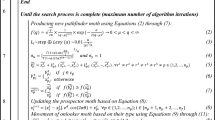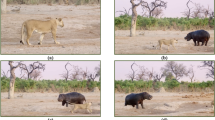Abstract
Phototaxis, signifying movement of an organism towards or away from a source of light, is one of the most representative features for moths. It has recently been shown that one of the characteristics of moths has been the propensity to follow Lévy flights. Inspired by the phototaxis and Lévy flights of the moths, a new kind of metaheuristic algorithm, called moth search (MS) algorithm, is developed in the present work. In nature, moths are a family insects associated with butterflies belonging to the order Lepidoptera. In MS method, the best moth individual is viewed as the light source. Some moths that are close to the fittest one always display an inclination to fly around their own positions in the form of Lévy flights. On the contrary, due to phototaxis, the moths that are comparatively far from the fittest one will tend to fly towards the best one directly in a big step. These two features correspond to the processes of exploitation and exploration of any metaheuristic optimization method. The phototaxis and Lévy flights of the moths can be used to build up a general-purpose optimization method. In order to demonstrate the superiority of its performance, the MS method is further compared with five other state-of-the-art metaheuristic optimization algorithms through an array of experiments on fourteen basic benchmarks, eleven IEEE CEC 2005 complicated benchmarks and seven IEEE CEC 2011 real world problems. The results clearly demonstrate that MS significantly outperforms five other methods on most test functions and engineering cases.





Similar content being viewed by others
References
Fu Z, Ren K, Shu J, Sun X, Huang F (2015) Enabling personalized search over encrypted outsourced data with efficiency improvement. IEEE Trans Parallel Distrib Syst 1–14. doi:10.1109/tpds.2015.2506573
Chen B, Shu H, Coatrieux G, Chen G, Sun X, Coatrieux JL (2015) Color image analysis by quaternion-type moments. J Math Imaging Vis 51(1):124–144. doi:10.1007/s10851-014-0511-6
Mohanty PK, Parhi DR (2015) A new hybrid optimization algorithm for multiple mobile robots navigation based on the CS-ANFIS approach. Memet Comput 7(4):255–273. doi:10.1007/s12293-015-0160-3
Kundu S, Parhi DR (2016) Navigation of underwater robot based on dynamically adaptive harmony search algorithm. Memet Comput 8(2):125–146. doi:10.1007/s12293-016-0179-0
Elsayed S, Sarker R (2016) Differential evolution framework for big data optimization. Memet Comput 8(1):17–33. doi:10.1007/s12293-015-0174-x
Zhang Y, Liu J, Zhou M, Jiang Z (2016) A multi-objective memetic algorithm based on decomposition for big optimization problems. Memet Comput 8(1):45–61. doi:10.1007/s12293-015-0175-9
Kennedy J, Eberhart R (1995) Particle swarm optimization. In: Paper presented at the Proceeding of the IEEE international conference on neural networks, Perth, Australia, 27 November–1 December
Dorigo M, Maniezzo V, Colorni A (1996) Ant system: optimization by a colony of cooperating agents. IEEE Trans Syst Man Cybern B Cybern 26(1):29–41. doi:10.1109/3477.484436
Karaboga D, Basturk B (2007) A powerful and efficient algorithm for numerical function optimization: artificial bee colony (ABC) algorithm. J Glob Optim 39(3):459–471. doi:10.1007/s10898-007-9149-x
Bullinaria JA, AlYahya K (2014) Artificial Bee Colony training of neural networks: comparison with back-propagation. Memet Comput 6(3):171–182. doi:10.1007/s12293-014-0137-7
Wang G-G, Deb S, Cui Z (2015) Monarch butterfly optimization. Neural Comput Appl. doi:10.1007/s00521-015-1923-y
Wang G-G, Deb S, Gao X-Z, Coelho LDS (2016) A new metaheuristic optimization algorithm motivated by elephant herding behavior. Int J Bio-Inspired Comput. http://www.inderscience.com/info/ingeneral/forthcoming.php?jcode=ijbic
Gandomi AH, Alavi AH (2012) Krill herd: a new bio-inspired optimization algorithm. Commun Nonlinear Sci Numer Simulat 17(12):4831–4845. doi:10.1016/j.cnsns.2012.05.010
Wang G-G, Gandomi AH, Alavi AH (2014) Stud krill herd algorithm. Neurocomputing 128:363–370. doi:10.1016/j.neucom.2013.08.031
Le MN, Ong Y-S, Jin Y, Sendhoff B (2009) Lamarckian memetic algorithms: local optimum and connectivity structure analysis. Memet Comput 1(3):175–190. doi:10.1007/s12293-009-0016-9
Meuth R, Lim M-H, Ong Y-S, Wunsch DC (2009) A proposition on memes and meta-memes in computing for higher-order learning. Memet Comput 1(2):85–100. doi:10.1007/s12293-009-0011-1
Storn R, Price K (1997) Differential evolution-a simple and efficient heuristic for global optimization over continuous spaces. J Glob Optim 11(4):341–359. doi:10.1023/A:1008202821328
Chong JK (2016) A novel multi-objective memetic algorithm based on opposition-based self-adaptive differential evolution. Memet Comput 8(2):147–165. doi:10.1007/s12293-015-0170-1
Khatib W, Fleming P (1998) The stud GA: a mini revolution? In: Eiben A, Back T, Schoenauer M, Schwefel H (eds) Proceedings of the 5th international conference on parallel problem solving from nature, New York, USA, 1998. Parallel problem solving from nature. Springer-Verlag, London, UK, pp 683–691
Simon D (2008) Biogeography-based optimization. IEEE Trans Evol Comput 12(6):702–713. doi:10.1109/TEVC.2008.919004
Gandomi AH, Alavi AH (2011) Multi-stage genetic programming: a new strategy to nonlinear system modeling. Inf Sci 181(23):5227–5239. doi:10.1016/j.ins.2011.07.026
Li X, Zhang J, Yin M (2014) Animal migration optimization: an optimization algorithm inspired by animal migration behavior. Neural Comput Appl 24(7–8):1867–1877. doi:10.1007/s00521-013-1433-8
Wang G-G, Deb S, Coelho LDS (2015) Earthworm optimization algorithm: a bio-inspired metaheuristic algorithm for global optimization problems. Int J Bio-Inspired Comput. http://www.inderscience.com/info/ingeneral/forthcoming.php?jcode=ijbic
Callahan PS (1977) Moth and candle: the candle flame as a sexual mimic of the coded infrared wavelengths from a moth sex scent (pheromone). Appl Opt 16(12):3089–3097. doi:10.1364/AO.16.003089
Reynolds AM, Jones HB, Hill JK, Pearson AJ, Wilson K, Wolf S, Lim KS, Reynolds DR, Chapman JW (2015) Evidence for a pervasive ‘idling-mode’ activity template in flying and pedestrian insects. R Soc Open Sci 2(5):150085. doi:10.1098/rsos.150085
Reynolds AM, Reynolds DR, Smith AD, Svensson GP, Lofstedt C (2007) Appetitive flight patterns of male Agrotis segetum moths over landscape scales. J Theor Biol 245(1):141–149. doi:10.1016/j.jtbi.2006.10.007
Li X, Yin M (2015) Modified cuckoo search algorithm with self adaptive parameter method. Inf Sci 298:80–97. doi:10.1016/j.ins.2014.11.042
Wang G, Guo L, Wang H, Duan H, Liu L, Li J (2014) Incorporating mutation scheme into krill herd algorithm for global numerical optimization. Neural Comput Appl 24(3–4):853–871. doi:10.1007/s00521-012-1304-8
Wang G-G, Guo L, Gandomi AH, Hao G-S, Wang H (2014) Chaotic krill herd algorithm. Inf Sci 274:17–34. doi:10.1016/j.ins.2014.02.123
Das S, Suganthan P (2010) Problem definitions and evaluation criteria for CEC 2011 competition on testing evolutionary algorithms on real world optimization problems. Jadavpur Univ., Nanyang Technol. Univ, Kolkata, India
Acknowledgments
This work was supported by Jiangsu Province Science Foundation for Youths (No. BK20150239) and National Natural Science Foundation of China (No. 61503165). The authors thanked Prof. Suash Deb and Prof. Leandro dos Santos Coelho’s help for improving language.
Author information
Authors and Affiliations
Corresponding author
Rights and permissions
About this article
Cite this article
Wang, GG. Moth search algorithm: a bio-inspired metaheuristic algorithm for global optimization problems. Memetic Comp. 10, 151–164 (2018). https://doi.org/10.1007/s12293-016-0212-3
Received:
Accepted:
Published:
Issue Date:
DOI: https://doi.org/10.1007/s12293-016-0212-3




